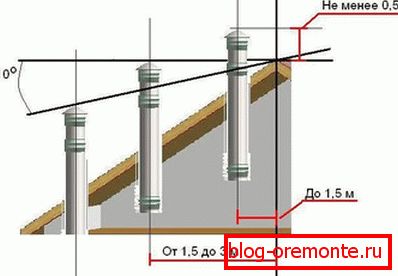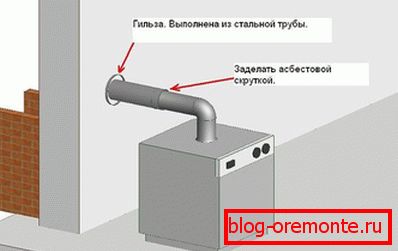Installation of the chimney itself
The fireplace is an important element for creating a pleasant and comfortable atmosphere in a country house. To ensure its normal operation, proper installation of the chimney is necessary. By correctly mounting the system to remove the combustion products, you can protect the fireplace or stove from various troubles and optimally heat the room. If installed incorrectly, you can provoke unwanted smoke, get backdraft, increase the likelihood of a fire. In this article we will tell about the installation of the chimney.
Design

Chimneys are equipped for the most efficient removal of the resulting combustion products. The beginning of the system is in the boiler, and the main part is the vertical channel. Next is the overlap and cutting of the channel, after which it goes into the bed. Another vertical pipe is located above the ridge of the roof and completes the construction of smoke extraction.
Due to the pressure and temperature drops, there is a thrust - directed air movement from the bottom up in the chimney. It is precisely the traction that ensures the correct and stable functioning of any heating system. The pipes in the flue duct must have maximum aerodynamic characteristics, and therefore structures with circular sections are preferably chosen. In such a configuration with smooth walls, the smoke can easily rise up without forming any turbulence.
Note! In order to avoid condensation, warm the pipes from the outside.
Materials
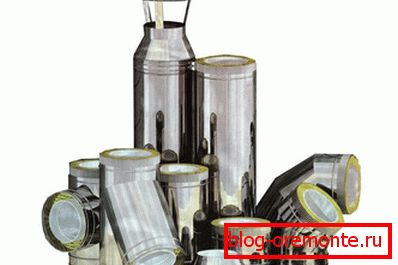
When installing the chimney, it is necessary to build on the characteristics of the stove or fireplace: the type of heater, the temperature of exhaust gases, the efficiency of the stove and its location in the house.
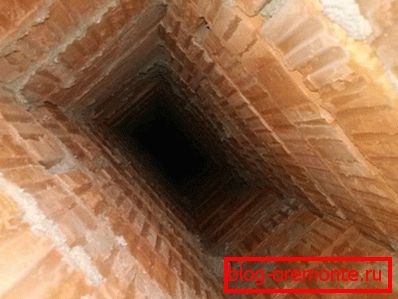
Until recently, the most popular versions of chimneys were brick, as a brick with no problems withstand high temperatures. And although such chimneys are still relevant today, they are not suitable for new types of modern heat generators using liquid fuels that have a greater efficiency than solid fuels. This is due to the fact that the heating temperature as a result of the combustion of the fuel is very low and is at a level below 160 degrees. When using such new furnaces, condensate forms on the walls, quickly destroying the chimney, made of porous brick and asbestos cement. In order to avoid destruction, it is necessary to use in the process of its construction dense non-combustible materials, for example, steel, ceramics or chamotte.
Note! The main advantages of modern steel chimneys are their smooth mirror surface. The polished surface allows the smoke to go outside unhindered.

Good traction, the absence of smoke on the walls of the stove or fireplace are the key to creating comfortable conditions in the house. The best option in the price / quality ratio is the special “sandwich” -type smoke pipe. This heat-insulated channel has a very impressive service life, the minimum indicators for the formation of condensate and the appearance of soot.
Note! To calculate the main parameters of the chimney, such as the diameter and the force of thrust, the main rule is applied - if the height of the pipe increases, then accordingly the thrust force should increase. If you do not adhere to this rule, you will get the effect of a chimney “choked” by the waste of combustion, when there is more smoke than it can take outside. In properly designed systems, their maximum functionality is calculated first, and only then the appearance and other elements are calculated.

The design depends on the installation site and the characteristics of the room. So for the internal chimney it is necessary to perform such additional work as installing supports, a protective casing and cutting. To carry out insulation in this case is not necessary, you only need to make insulation. In variants of external attached systems, usually consisting of a flue, the main wall bracket and sections, it is imperative to insulate the pipe properly. A conventional cylinder will be the best option for the shape of the chimney, providing an unobstructed passage of smoke.
Note! When choosing a different form, it is worth adhering to simple schemes of the chimney device, since complex variants usually cause soot accumulation. The height of the channel must be at least 5 meters.
Installation

The system is usually assembled from bottom to top. Mounting the pipe correctly in this order - each subsequent segment of it is inserted into the link of the previous one. Such operations can protect the chimney from moisture and condensate. To ensure better protection and tightness, it is worth using heat-resistant sealant.
All joints formed during assembly should be fixed with special clamps. Install the brackets along the gasket, with a pitch of about 2 meters, they will serve as fasteners to the building. Be sure to check the areas located horizontally, excluding their contact with other communications, such as gas and electrical wiring.
Note! When the pipe is located next to a flammable finish, thermal insulation of this area is required.
To properly protect the exterior of the chimney from various weather phenomena, you can use deflectors, weather vane. Although such protection is not always appropriate. So, for stoves on gas equipment - it will be a strict violation of safety.
Brick masonry chimney
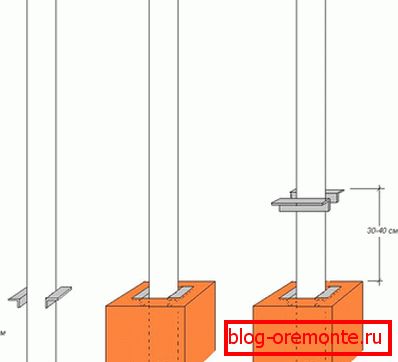
The laying of a brick chimney requires very high qualifications and extensive experience. Without having developed practices, it is necessary to constantly study all available specialized information and educational materials (literature, video) on this topic. For the construction of the same internal brick channel a lot of experience is not required. It is necessary to leave an unencumbered shaft in the main bearing wall, the dimensions of which will be equal to the brick in a horizontal position.
When arranging a detached brick-type construction, standing separately and not adjacent to the wall, the work is carried out very carefully. The masonry is made more precisely, the walls must be very smooth, and the corners of the structure must be straight. The strict verticality of the channel being created is very important. It is worthwhile to provide special holes in the masonry in advance, and to make a hatch in the lower part to further remove the soot that forms.
Major mistakes

Some errors made during construction may cause a fire or carbon monoxide poisoning. The consequences include the costly reworking of the chimney. Need to choose the right material for laying. So, for some types of stoves and fireplaces, ordinary brick will be suitable, while in others its use will simply be unacceptable.
Errors that are the most dangerous and lead to the impossibility of operating the entire system:
- poor insulation;
- improper installation of the ventilation system, which leads to the ingress of smoke and carbon monoxide into the house;
- modification of the design or repair without preliminary calculations.
These are all nuances of the construction of the chimney, but they need to know when starting construction. Carefully study the requirements for the creation of the heating system and the laying of the fireplace, as in the case of negligence and lack of qualification the risk of an accident is very high. Get a wizard consultation or invite him to inspect the built chimney.
A photo


